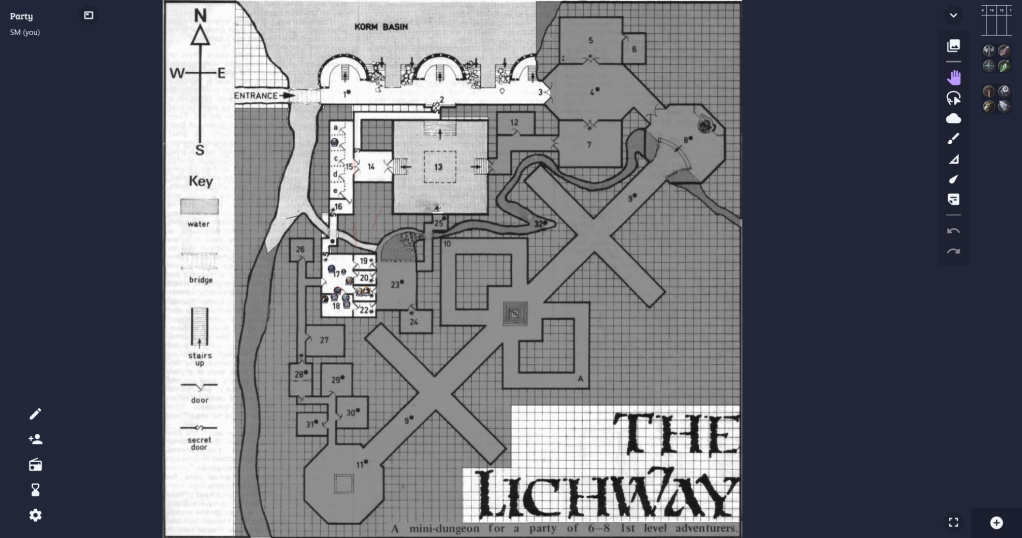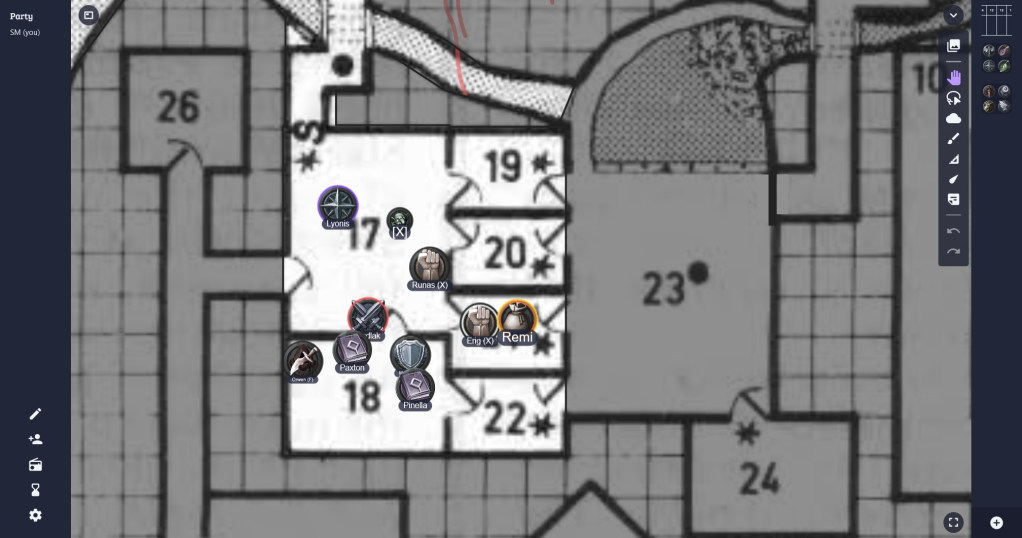Today we completed a single session of The Lichway, a 1977 AD&D/BX module published in White Dwarf #9. To play this we used The Lichway Project, a modern conversion of the module text to modern design sensibilities. We used The Vanilla Game (aka TVG) as the rule set, stored our characters in this Google Sheets template, and played using Owlbear. The players are 5e regulars.
Without giving away spoilers yet – this scenario rocks, and TVG was a perfectly fine accompaniment to this scenario. But you could use any OSR style rule set, it wouldn’t matter (I was actually tempted and almost chose to run it with Into the Odd).
Key observations for the session
The attack “whiffing problem” is still there for 1st level PCs. One player just had bad luck and rolled almost entirely high on his d20s, missing everything. I felt so bad for him. This is why I’m gravitating towards rule sets like Into the Odd, Cairn, etc. I think TVG’s starting AV difference between Fighters and Magic-Users should be 2 instead of 1, so I would add +1 to Fighter AV from the tables, so 12-18 AV effectively.
TVG has a Fighter class ability which is great: “When you kill a foe with a melee attack, you may immediately make another melee attack.” There was a kind of shared glee among the players when one of their fighters chained a few lucky hits into multiple kills in a round. I think if you played a lot of TVG, you’d probably want to build up a set of these powers and let new Fighters choose one, for a bit of uniqueness. For example, swap melee for ranged and you now have a ranger type. Another example – if you look at “Special Attacks”, there’s a rule: “If you attack an enemy unawares, apply damage directly to Flesh, bypassing Grit.” – perhaps an “Assassin” type could have their Fighter class ability giving them +4 for advantage based attacks and damage (instead of +2). Stuff like that.
Flesh and Grit – for adversaries, I adapted them from the source module on the fly using the “low average” of a d6: Flesh=3+HD, Grit=3xHD. So a 1 HD monster is F4/G3, a 3 HD monster is F6/G9. Enough to absorb a hit or two before going down. For bosses or whatever I’d roll as per TVG’s rules for the unpredictability.
Spell-casting is interesting, but potentially too punitive. I love how there is no level restriction on casting spells. The mechanics around magic in combat seem punishing. A L1 Magic-User’s ST is 6 (30% chance) – not the best to avoid Corruption/Miscast. I would make one small change: only roll on the miscast table when casting corrupted spells. Effectively these text changes I would make:
Casting Spells
If you fail to control a spell while casting from your spellbook, mark it Corrupted. Take damage equal to the spell’s level. The spell works.
Corrupted Spells
When you quickly cast a Corrupted spell (in a combat Round), take damage equal to the spell’s level, and roll on the Miscast Table.
It’s amusing how quickly games can turn into a legal debate – i.e. TVG’s invisibility spell. Does that include clothing and equipment? OK sure, it covers those. What if I pick up keys and put them inside my invisible backpack? What if I put down my invisible sword? Can I see my own invisible sword? One recommendation I have is to grab an OSR rules text that’s more “complete” than TVG and use that for disambiguation. OSRIC, BFRPG, or OSE are good references. For example, here is TVG’s spell description:
Invisibility
Level 2, sight, indefinite.
Target being or object becomes invisible. Lasts until dispelled or the target makes an attack.
And here is BFRPG’s:
Invisibility
Range: touch
Magic-User 2
Duration: specialThis spell causes the creature touched (who may be the caster) to become invisible, undetectable by normal vision or Darkvision. Invisible creatures may be detected by those with non-visual sensory abilities.
All items worn or carried by the target when the spell is cast become invisible as well. If the target lays down an invisible item, it instantly becomes visible again; on the other hand, items picked up do not automatically become invisible. If the target places a visible item entirely inside its invisible clothing, backpack, pouch, or other container so that if the target were visible the item could not be seen, it will become invisible just as if it were held when the spell was cast.
Note that casting this spell upon another makes the target invisible to the caster as well as everyone else. A party of invisible characters will likely experience problems with running into or tripping over each other.
The spell lasts at most 24 hours if not ended sooner. It ends instantly if the target attacks an opponent or casts any spell. Other actions do not normally end the spell. The target may end the spell at will.
Objects that shed light may be made invisible but the light itself will remain visible, and the source of that light (and the character carrying it) can thus be discovered. Rain, dust, paint, and any other visible substance thrown or applied to an invisible creature will also render it detectable.
Owlbear Rodeo was very good overall, but with one caveat – it had performance issues with revealing fog of war as the players explored. Now, this tool is amazing and beyond my own coding abilities no doubt, but clearly a performance tuning of their JavaScript would be good. Perhaps offloading calculations to Web Workers or similar.
(Spoilers!) The Jailer’s Room in The Lichway module is very awkward:
- The Jailer’s Room
A room dimly lit by a lonely torch; a smell of wine in
the air.
➔ Pinella, naked and bound, lies on a bunk.
➔ Vivlok, an uggly man whose face is covered in warts and sores, is panting beside the bed.
I personally would tone the implications of this one down significantly. I would clothe Pinella and instead imply Vivlok is a simpleton who instead cares for her like a daughter or something “creepy but not rapey”. Perhaps he’s giving her a drink of water, implying the prisoners are being neglected in general.
(Spoilers!) Screenshots
Here’s what they managed to explore in a few hours of play, after character creation in TVG. As you can see, they found the secret doors at the main entrance. For the second door, I paid close attention to how they were searching, and allowed them to find it as soon as they pushed on the rear section of the compartment.
They then ended up the session by fighting Dark Odo’s gang, but did not confront Odo herself, who has chosen discretion as the better part of valor in this engagement and had retreated above the waterfall.

The final battle ended like so:

Conclusions
- The Lichway is a wonderful module, and I hope I get the chance to return to it. But how should the environment change? And why is Dark Odo hanging out there anyway? What will she do now her gang is defeated? Will any other groups take over her area?
- The Vanilla Game is a solid OSR game with some nice mechanics that my players responded to and enjoyed.
- Owlbear is a solid tool for maps with fog-of-war, just be careful about its performance. Perhaps Google Chrome works better over Firefox?